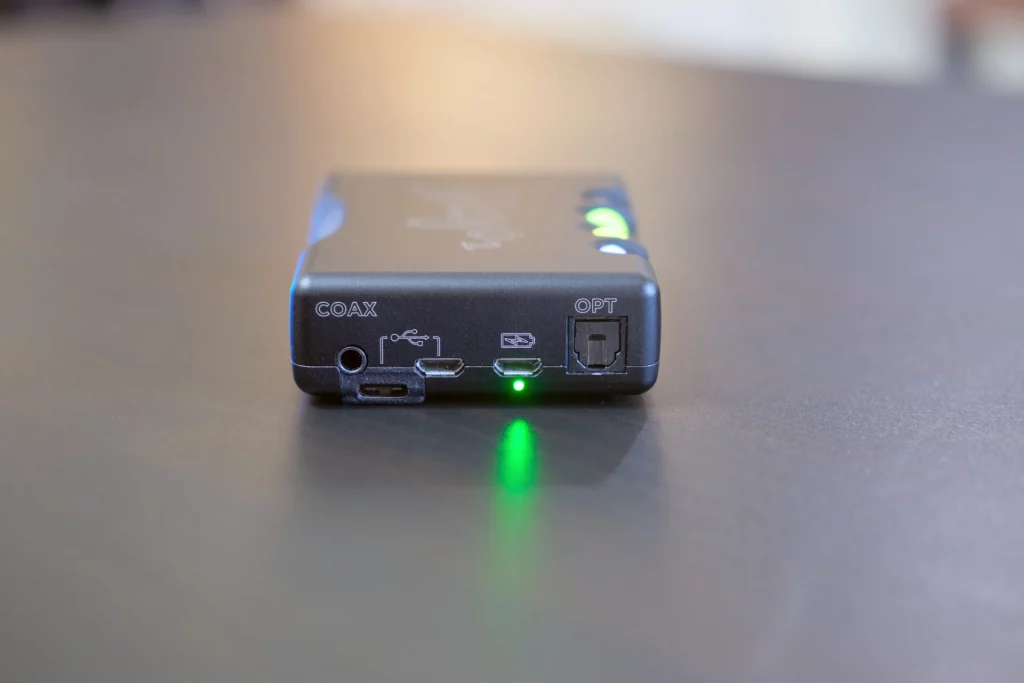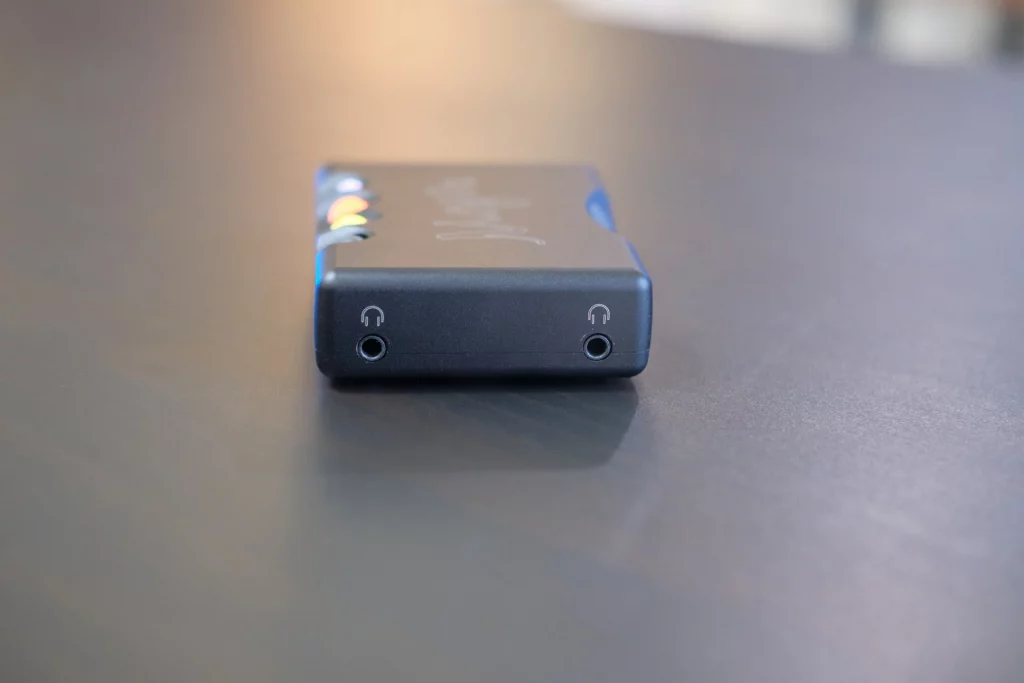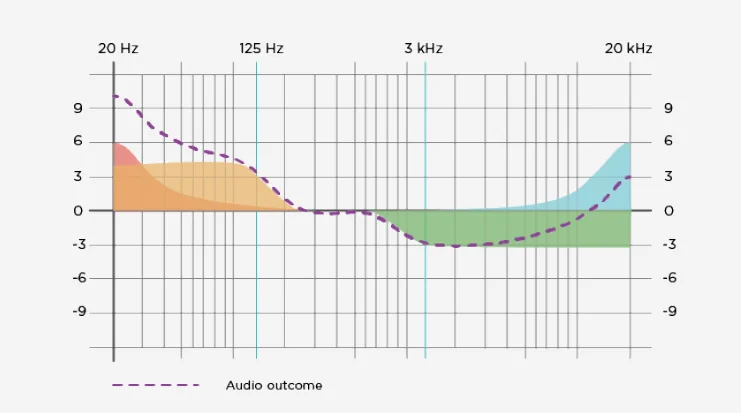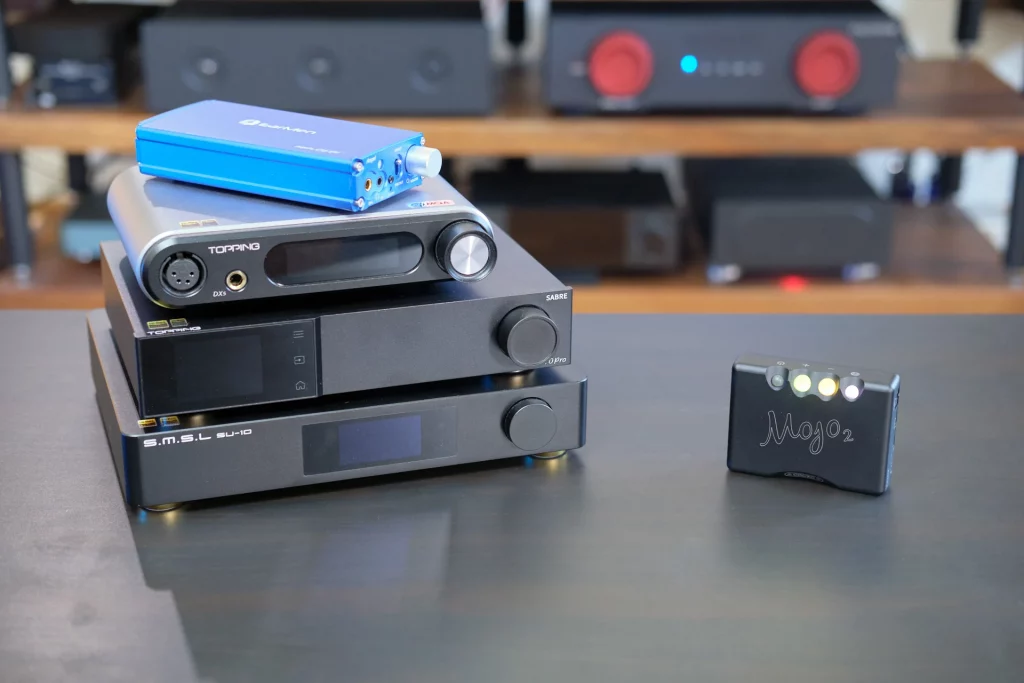Chord needs no introduction to any HiFi enthusiast, especially the ones using D/A converters. The brand’s most affordable model Chord Mojo became as famous as DAC can be, but competition grew very strong so Mojo 2 was necessary to keep up with the market. Let’s find out how it performs and how it fares against competition.
Build and Connectivity
Chord Mojo 2 has the same style, build quality, and form factor as its predecessor. This means the whole device is machined out of aluminum and feels very solid. This also means that for controlling the device we use several balls, four this time instead of three, and they light up in different colors which change while you’re using Mojo 2’s different functions. This can get pretty hectic in the beginning while you develop some muscle memory. Not a big fan of this, to be honest, it made me look at the manual much more often than I would ever care to.
The small size also means that most connections had to be of a mini or micro variety. On one side we can find several digital inputs: USB-C, micro USB, Optical Toslink, and 3.5mm Coaxial SPDIF input. I have to say this is quite an impressive selection of inputs for such a small device. Charging is still done by a separate micro USB port.


The other side of the device hosts two 3.5mm outputs that can both be used simultaneously. This might be a good save for young lovebirds doing that cheesy thing – listening to the same tune by sharing one set of headphones, meaning that each gets only one headphone. Preposterous practice if you ask me and Chord seems to agree.
Features
Chord Mojo 2 is once again using proprietary FPGA technology with custom-made digital filtering to provide the house sound. Line output can get as high as 5.2 V when the volume is fully maxed out, and there isn’t any option to engage a fixed-level output, volume control will always be active, so you can decrease the output level at your own will. When headphones are connected, you can expect a reasonable amount of power for a small and portable device:
- 90 mW 300 ohms (5.2 V RMS)
- 600 mW 30 ohms (4.2 V RMS)
I’m not going to dwell on tech specs so if you want to know more about that, take a look at the table down below the review. But there are a few important things worth mentioning here. The first among them is that Mojo 2 is still compatible with Poly streamer. The next one is that Chord implemented automatic desktop mode – meaning that if you keep Mojo 2 connected to the power supply for a longer period, it will switch to powering directly from the power supply instead of using the battery and charging it all the time. This will prolong the battery’s life. Last but not least, Chord implemented a powerful EQ function. This one lets you manipulate frequency response using four different bands. Looking at the image should make it easy to understand.

What’s even more interesting is that I couldn’t detect any loss of audio quality when using this EQ, which I usually do. Enabling any sort of software EQ degrades the sound quality to some degree. But this time I simply couldn’t hear it. It seems that Chord uses some hardware processing, and I can only guess that the signal is going through it for other purposes, EQ-enabled or not. In other words, this is a fantastic addition that makes Mojo 2 more adaptable and versatile, without drawbacks. Great stuff.
Sound (DAC – Line Output)
Chord Mojo 2 is tonally very well judged. The bassline is weighty but shows good control and doesn’t hide tone details. There’s a hint of warmth in the bass and midbass region, but not too much. The midrange is lush and full-bodied, yet very revealing of tone texture. All vocals, male and female, sound as beautiful and natural as it gets anywhere near this price. The same goes for any acoustic instrument – wind, string, brass, or wood – it doesn’t matter, tone timbre is always rich and natural. The highest frequencies are revealing and airy too, but never sharp or edgy in any way. If anything, Mojo 2 might be on the softer and more mellow side of things.
Softer and milder presentation extends to dynamics too. While Chord Mojo 2 is not flat or boring sounding by any means, it doesn’t do big dynamic swings with authority. Several DACs at this price range do sound more explosive and dynamic, but more on that in the comparison section.
Lastly, Mojo 2 develops a decently spacious, airy, and three-dimensional soundstage. It’s not the biggest there is, but it’s sure not far away either. However, what it lacks in sheer width, little Chord compensates with big and believable individual tones. Each tone has a realistic size between my speakers and feels quite palpable in space. Not many DACs achieve this.
Sound (Headphone Output)
I’ll keep it short and to the point here. When used with headphones, Chord Mojo 2 sounds basically the same tonally as it does when used as a DAC. We’re talking about tonally rich and lush sound, that shows decent but not class-leading dynamics. If used in a desktop environment, more complete-sounding products can be found, but as a small portable device – it’s as good as it gets at this price point.

Comparisons
EarMen Angel – The blue portable DAC and headphone amplifier, seen on the top of the pile in the image above. Angel sounds equally revealing but it is tonally leaner and thiner. It focuses more on crisp tone edges than it does on tone timbre. Mojo 2 sounds tonally richer and fuller, so I consider it to be a more accomplished device sonic-wise. At the time when I first got this Chord, it was going for its original price of $750, and Angel was still at its original price of $799 – so the choice was very easy – Chord was winning. But nowadays, Mojo 2 is permanently lowered to $650 while Angel is at a stunningly low $399, which puts it back into the game as a fantastic value proposition.
Topping DX5 or SMSL DO400 are both great devices on their own and more affordable too. However, when put directly against Chord Mojo 2 they can’t reveal the same amount of fine details and their tone timbre is not as rich. Mojo 2 is simply a better-sounding device but more expensive. But the EarMan Angel with its new significantly reduced price is now the real pain in the neck for these two since it is a better performer too.
xDuoo XD-05 Pro is slightly pricier at $750, it’s also portable but noticeably bigger and chunkier. With this one, you can choose different DAC modules and different op-amps to tune the sound more to your liking. But in its out-of-the-box state with Sabre DAC module and default op-amps, it does sound livelier than Mojo 2 when used with headphones. Overall detail retrieval is similar but dynamics are noticeably better and soundstage is bigger. Mojo 2 sounds dynamically and spatially flat in a direct comparison. Things do turn around if you use them both as DACs only – now Mojo 2 is slightly bigger and lusher sounding compared to a bit flatter XD-05 pro.
Rose Technics RT5000 is a newcomer that sells for $599 and it is a desktop product from a new and unknown brand that I’ve recently reviewed on my YouTube channel. If you don’t need your device to be portable, this one is a fantastic headphone amplifier and a DAC. Using it as a DAC it will match Mojo 2 in terms of soundstaging, tone fullness, and overall smoothness. But move to headphones and it will perform at a level of clarity and dynamics, with a spacious soundstage, that will leave Mojo 2 sounding flat and bland. I’m well aware that a new Chinese brand that sells only online will not be everyone’s cup of tea, but the price-to-performance ratio of this device is unbeatable at the moment of writing this review.
Conclusion
Chord Mojo 2 is well-built, small, and quirky. Once you’re used to its weird controls and looks you’ll notice a very capable device underneath. It packs a competent head-amp and sounds very good when headphones are connected – but it can be beaten in that regard by some newer devices. Using it as a DAC is where it shines the most. Sure, some DACs will sound faster, or more dynamic, but Mojo 2 holds its own with fantastically rich midrange and tone timbre, and hardly anything up to $1000 will beat it hands down in all aspects. To answer the question from the title – no, Chord Mojo 2 is not overpriced or overhyped – I say its fame is well-deserved.
| CHORD MOJO 2 – CHARACTERISTICS |
|
Five digital inputs: coaxial, dual-data coax, optical, Micro-USB and USB-C |







Well written with persoanlity and insights. Great comparsons for context.
Hi, in the Czech Republic is Mojo 2 currently available for 482 USD. I am considering buying one. Now i have AKG K812 PRO and planar TinHifi P1 Max.
That’s a very good price.